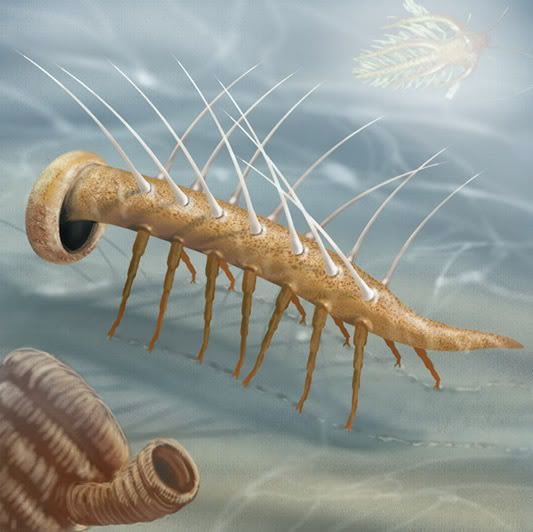Post by Barry the Baryonyx on Aug 26, 2007 13:51:47 GMT -5
Hallucigenia

© 2003 by Karen Carr
Hallucigenia is an extinct genus of animal found as fossils in the Middle Cambrian-aged Burgess Shale formation of British Columbia, Canada. It was named by Simon Conway Morris when he re-examined Charles Walcott's Burgess Shale genus Canadia in 1979. Morris found that what Walcott had called one genus in fact included several quite different animals. One of them was so unusual that nothing about it made much sense. Since the species clearly was not a polychaete worm, Morris had to provide a new generic name to replace Canadia. Morris named the species Hallucigenia sparsa because of its "bizarre and dream-like quality" (like a hallucination).
The 0.5 to 3 cm-long animal is wormlike — that is, long and narrow — with a poorly defined blob, or stain, on one end. This "blob" was arbitrarily designated the 'head' even though it had none of the features generally associated with heads: mouth, eyes, or other sensory organs. The animal has seven pincher-tipped tentacles lined up on one side and seven pairs of jointed spines on the other. Six of the tentacles are paired with spines, while one is in front of the spines. There are also six smaller tentacles which may be configured in three pairs behind the seven larger ones. In addition, there is a flexible, tube-like body extension behind the tentacles.
Faced with an animal that had no obvious head and two types of appendages, neither of which seemed appropriate for any reasonable form of locomotion, Morris assigned the blob as the head and hypothesized that the spines were legs and that the tentacles were feeding appendages. Morris was able to demonstrate a workable if improbable method of walking on the spines. Only the forward tentacles can easily reach to the 'head,' meaning that a mouth on the head would have to be fed by passing food along the line of tentacles. Morris suggested that a hollow tube within each of the tentacles might be a mouth. This is a less-than-satisfactory reconstruction, but it was accepted as the best available. A picture of the animal as reconstructed by Morris can be found at.
An alternative interpretation favored by some paleontologists was that Hallucigenia is actually an appendage of some larger, unknown animal. Given the uncertainty of its taxonomy, Hallucigenia was tentatively placed within the phylum Lobopodia, a catch-all clade containing numerous odd "worms with feet."
In 1991, Ramiskold and Hou Xianguang, working with additional specimens of a "hallucigenid" from the lower Cambrian Maotianshan shales of China, reinterpreted Hallucigenia as an Onychophore. They inverted it, interpreting the tentacles, which they believe to be paired, as walking structures and the spines as protective. Interestingly, none of the 30 or so known Burgess Shale specimens shows any sign of pairing in the large tentacles; nor do their Chinese counterparts. The pairing is based on a dissection of the actual fossil, which revealed what is probably a second tentacle structure. Ramiskold and Hou also believe that the 'head' is actually a stain that appears in many specimens, not a preserved portion of the anatomy.
Though Ramiskold and Hou's is the accepted modern interpretation, it is far from problem-free. Unlike its contemporary Aysheaia, Hallucigenia has very little resemblance to modern Onychophora. The possibly paired pincher-tipped tentacles bear little resemblance to the paired annulated legs of the Onychophora. It is unknown what the spines were made of and how much 'protection' they offered. They do not seem to be preserved independent of the soft-shelled animals as carbonate or chitinous shells would probably be. It is not easy to explain why 30 or more specimens — each hypothesized to have seven pairs of rather long, flexible legs — do not show even one example of paired legs. But at least this reconstruction of the animal can plausibly walk, and the spines serve a reasonable purpose. A picture of this reconstruction as well as a photograph of an actual fossil can be seen at.
Some paleontologists accept Ramiskold and Hou's interpretation of the animal's legs, spines, and head, but also believe that Hallucigenia might be an "armored lobopod" related to Anomalocaris, rather than (or as well as) being related to the Onychophora.
© 2007 Answers Corporation


 Is it just us?
Is it just us?